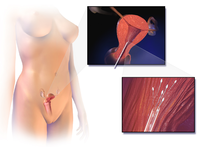
Photo from wikipedia
To determine effects of timed artificial insemination (TAI) hormonal treatments on reproductive performance of gilts/sows and explore molecular mechanisms, gilts (TAI: 90; Control:149; Total: 239) and sows (TAI: 370; Control:… Click to show full abstract
To determine effects of timed artificial insemination (TAI) hormonal treatments on reproductive performance of gilts/sows and explore molecular mechanisms, gilts (TAI: 90; Control:149; Total: 239) and sows (TAI: 370; Control: 492) were utilized. Results indicated the estrus/farrowing rate and number of piglets born alive and weaned in the TAI group were greater than in the control group for both gilts and sows. To explore the molecular mechanism for TAI hormonal effects, the small RNA of the gilt endometrium at 16 and 25 of gestation were sampled and sequenced to determine potential functions of microRNA (MiRNA); 358 known and 142 novel MiRNAs were detected. With comparison of TAI and control groups, there were 54 differentially abundant MiRNAs, and functional analysis results indicated "binding," "protein/ion binding," and "immune response" were mostly enriched. In addition, representative MiRNAs were selected based on criteria including being regulated on both day 16 and 25 of gestation (ssc-miR-10a-5p, ssc-miR-345-5p, ssc-miR-370) along with reproduction-related target genes (ssc-miR-424-5p, ssc-miR-142-5p). Furthermore, target genes of selected MiRNAs were screened, and functional enrichment of those genes also indicated that the "binding" and "immune response" were mainly enriched. Results from the present study confirmed TAI-hormonal treatments improved estrous/farrowing rate and number of piglets born alive/weaned of gilts/sows and that hormonal treatment regimens leading to behavioral estrus at timed artificial insemination in gilts results in microRNA patterns in the endometrium that are more supportive of pregnancy. Results contribute valuable information for future studies of effects of TAI hormonal treatments on pig reproductive performance.
Journal Title: Animal reproduction science
Year Published: 2021
Link to full text (if available)
Share on Social Media: Sign Up to like & get
recommendations!